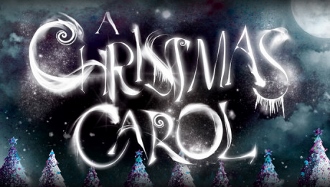ROLL OUT THE CAROL
For two generations, a yearly outing to see A Christmas Carol has been a feel-good tradition for San Francisco families. American Conservatory Theater (A.C.T.) has staged adaptations of this famous Dickens story continuously since 1976, with few gaps, changing up the production on a regular basis to keep it from getting stale. Right along with attending SF Ballet’s The Nutcracker and watching the big Christmas tree light up in Union Square, witnessing Scrooge’s transformation from bitter old miser to generous and cuddly geezer meant the holidays were finally here. For many locals, A Christmas Carol was their first exposure to live theatre, and they loved the experience so much that they now bring their own kids to continue the tradition.
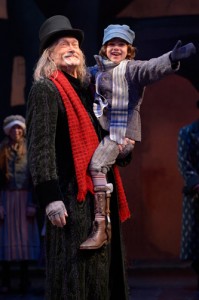 Condensing a lengthy work of Victorian literature into an evening’s entertainment is no mean feat, especially when the audience typically includes a high percentage of wee ones who need to be in bed at a reasonable hour. The current production (which runs to barely two hours, with intermission) is so kid-friendly, however, that it feels almost cartoonish. As adapted by Carey Perloff and Paul Walsh, the plot has been stripped down to its barest, Reader’s Digest essentials. This is a pity. Don’t get me wrong: Even with the plot’s cursory feel, it is definitely a show that pumps out a lot of jolly good fun. But one of the great appeals of this play is that its central themes cut across age lines. There is plenty of action and visual spectacle to surprise and delight the little guys, but adults may feel a bit cheated that the meatier theme of Scrooge’s moral epiphany (generosity is its own reward) comes too easily and lacks dramatic suspense. This is a Happy Meal version of this Christmas classic. Where’s the beef?
Condensing a lengthy work of Victorian literature into an evening’s entertainment is no mean feat, especially when the audience typically includes a high percentage of wee ones who need to be in bed at a reasonable hour. The current production (which runs to barely two hours, with intermission) is so kid-friendly, however, that it feels almost cartoonish. As adapted by Carey Perloff and Paul Walsh, the plot has been stripped down to its barest, Reader’s Digest essentials. This is a pity. Don’t get me wrong: Even with the plot’s cursory feel, it is definitely a show that pumps out a lot of jolly good fun. But one of the great appeals of this play is that its central themes cut across age lines. There is plenty of action and visual spectacle to surprise and delight the little guys, but adults may feel a bit cheated that the meatier theme of Scrooge’s moral epiphany (generosity is its own reward) comes too easily and lacks dramatic suspense. This is a Happy Meal version of this Christmas classic. Where’s the beef?
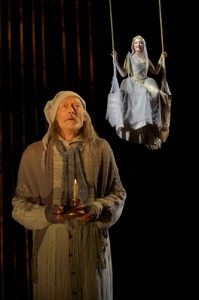 The problem is that Scrooge’s hard shell cracks far too early in the play. The tension that makes Scrooge’s story so compelling is how agonizingly long it takes for him to realize the error of his coldly capitalistic ways. Three Christmas Spirits and a host of “shadows” need to work their phantom tushies off to wake Scrooge up and make him feel the love. In this staging, however, Scrooge (James Carpenter) gets too mushy when the Spirit of Christmas Past (played by Rebekah Brockman with the physical grace of a trapeze artist) conjures up images of the young Ebenezer’s childhood, little more than half-way through the Act 1. Scrooge’s soft center oozes out again when he sees a foreshadowing of the death of Tiny Tim, the crippled and saintly youngest child of his hapless employee Bob Cratchit. Scrooge is a tough nut, but cracks far too easily. By the end of the play, as he doles out turkeys and shillings with manically generous glee, his catharsis’”his redemptive change of heart’”feels rather limp and anticlimactic.
The problem is that Scrooge’s hard shell cracks far too early in the play. The tension that makes Scrooge’s story so compelling is how agonizingly long it takes for him to realize the error of his coldly capitalistic ways. Three Christmas Spirits and a host of “shadows” need to work their phantom tushies off to wake Scrooge up and make him feel the love. In this staging, however, Scrooge (James Carpenter) gets too mushy when the Spirit of Christmas Past (played by Rebekah Brockman with the physical grace of a trapeze artist) conjures up images of the young Ebenezer’s childhood, little more than half-way through the Act 1. Scrooge’s soft center oozes out again when he sees a foreshadowing of the death of Tiny Tim, the crippled and saintly youngest child of his hapless employee Bob Cratchit. Scrooge is a tough nut, but cracks far too easily. By the end of the play, as he doles out turkeys and shillings with manically generous glee, his catharsis’”his redemptive change of heart’”feels rather limp and anticlimactic.
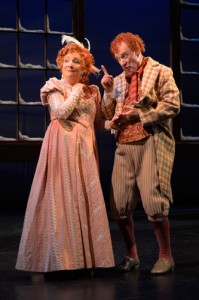 Mr. Carpenter puts in a convincingly nasty and ultimately sympathetic performance as the iconic miser. Though white-haired and rather gaunt, he is far from being a pathetic codger. There is something genuinely menacing and villainous about this bitterly cold-hearted man. His venomous rants against the poor and “undeserving” are spat out with all the flint-hearted zeal of a gonzo Tea Party candidate. Pontificating about the need for more debtor’s prisons and poor-houses to handle society’s outcasts, he could be the Victorian Era’s answer to Dick Cheney. When Scrooge finally bursts out of his self-made misanthropic carapace and reawakens his long-slumbering humanity, Carpenter portrays Scrooge as giddily disoriented by how good he feels. He handles this transformation skillfully, giving the audience a vivid sense of Scrooge’s euphoria.
Mr. Carpenter puts in a convincingly nasty and ultimately sympathetic performance as the iconic miser. Though white-haired and rather gaunt, he is far from being a pathetic codger. There is something genuinely menacing and villainous about this bitterly cold-hearted man. His venomous rants against the poor and “undeserving” are spat out with all the flint-hearted zeal of a gonzo Tea Party candidate. Pontificating about the need for more debtor’s prisons and poor-houses to handle society’s outcasts, he could be the Victorian Era’s answer to Dick Cheney. When Scrooge finally bursts out of his self-made misanthropic carapace and reawakens his long-slumbering humanity, Carpenter portrays Scrooge as giddily disoriented by how good he feels. He handles this transformation skillfully, giving the audience a vivid sense of Scrooge’s euphoria.
In a large and multi-generational cast, there are several standouts. Sharon Lockwood as Scrooge’s housekeeper, Mrs. Dilber, delivers sure-footed comic relief, a cockney Gracie Allen. In a scene where she helps Scrooge get ready for bed, her dingbat dithering over nightshirts and slippers makes this minor moment memorable.
An A.C.T. veteran, Ken Ruta, takes a hilariously ghastly turn as the Ghost of Jacob Marley, popping out of an opening in the middle of Scrooge’s bed like an ectoplasmic jack-in-the-box. As he intones his warnings about the imminent visitations from the Ghosts of Christmas, his goofy goggle-eyed expression and wild frizzed-out hair reminds one of a spectral version of Kramer, the quirky neighbor in Seinfeld.
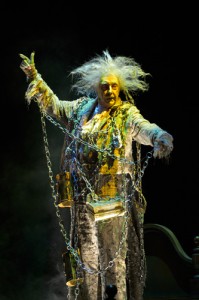 The Ghost of Christmas Present (Omozé Idehenre) is a gorgeously pagan Earth-Mother-meets-Disco-Diva, clad in yards of lush green velvet and gold trim. She whirls around like a shaman on loan from the Emerald City, shaking her enormous branch/wand to conjure up the more physical pleasures of the yuletide season: rich foods, dancing, glasses of grog, kisses under the mistletoe. She’s the kind of spirit you’d want to have haunting all your holiday parties.
The Ghost of Christmas Present (Omozé Idehenre) is a gorgeously pagan Earth-Mother-meets-Disco-Diva, clad in yards of lush green velvet and gold trim. She whirls around like a shaman on loan from the Emerald City, shaking her enormous branch/wand to conjure up the more physical pleasures of the yuletide season: rich foods, dancing, glasses of grog, kisses under the mistletoe. She’s the kind of spirit you’d want to have haunting all your holiday parties.
There is plenty of fun stuff to lighten things up along the way and keep the younger audience members engaged. Frequent interludes of music and songs, written by Karl Lundeberg, give the actors a chance to showcase their dancing and vocal talents. The classic Christmas party scene in Fezziwig’s warehouse is a total romp, with the young Scrooge and his co-workers dancing the night away in a well-choreographed ensemble number, decked out in their high-Victorian holiday finery. All the fiddling and fancy footwork, courtesy of choreographer Val Caniparoli, makes you want to grab a cup of punch and join in the festivities.
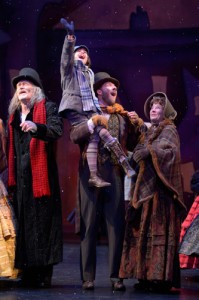 The cast includes many children, members of the A.C.T. Young Conservatory. Their freshness and enthusiasm provide a welcome energy boost. In an early scene at Scrooge’s dismal business office, a choir of London street urchins sings with touching sweetness outside his window, provoking a furious reaction in Scrooge and the first of many “Bah! Humbugs.” Opening Act 2, as the Ghost of Christmas Present reminds Scrooge of how much pleasure Christmas can bring, we are treated to the silly and surreal spectacle of a youthful chorus line of figs, onions and plums urging Scrooge to loosen up and enjoy life in a dance number called “Heavenly Fruit.” It’s like something out of an old Busby Berkley Hollywood musical. These talented youngsters (Chloe Durham, Rachel Metzger, Lindsay Sohn, Emma Sutherland, Shalan Lee, Katherine Liviakis) sing and dance with a lots of verve and considerable talent – they were a pleasure to watch.
The cast includes many children, members of the A.C.T. Young Conservatory. Their freshness and enthusiasm provide a welcome energy boost. In an early scene at Scrooge’s dismal business office, a choir of London street urchins sings with touching sweetness outside his window, provoking a furious reaction in Scrooge and the first of many “Bah! Humbugs.” Opening Act 2, as the Ghost of Christmas Present reminds Scrooge of how much pleasure Christmas can bring, we are treated to the silly and surreal spectacle of a youthful chorus line of figs, onions and plums urging Scrooge to loosen up and enjoy life in a dance number called “Heavenly Fruit.” It’s like something out of an old Busby Berkley Hollywood musical. These talented youngsters (Chloe Durham, Rachel Metzger, Lindsay Sohn, Emma Sutherland, Shalan Lee, Katherine Liviakis) sing and dance with a lots of verve and considerable talent – they were a pleasure to watch.
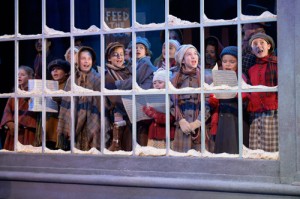 Visually, the production has flair but is also quite uneven. Many of John Arnone’s sets are simplistic to the point of cheesiness: the 19th-century London street-scenes in Act 1 look hastily made and have the production values of a high school play. Ditto for the graveyard scene in Act 2, which looked like a Halloween haunted house the neighbors might have put up. Interior spaces (Scrooge’s office, his nephew Fred’s parlor, Fezziwig’s warehouse) are more effective, tricked out with well-chosen details that suit the mood of the scene. The mismatched chairs around the Cratchit’s dining room table imbued the domestic life of this impoverished but happy family with sweet pathos – what they lacked in furnishings and money was more than made up for with the joy they took in each other’s company.
Visually, the production has flair but is also quite uneven. Many of John Arnone’s sets are simplistic to the point of cheesiness: the 19th-century London street-scenes in Act 1 look hastily made and have the production values of a high school play. Ditto for the graveyard scene in Act 2, which looked like a Halloween haunted house the neighbors might have put up. Interior spaces (Scrooge’s office, his nephew Fred’s parlor, Fezziwig’s warehouse) are more effective, tricked out with well-chosen details that suit the mood of the scene. The mismatched chairs around the Cratchit’s dining room table imbued the domestic life of this impoverished but happy family with sweet pathos – what they lacked in furnishings and money was more than made up for with the joy they took in each other’s company.
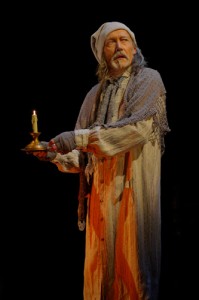 A striking set piece used in this production is a huge black cloth puppet, portraying the Ghost of Christmas Future. 20 feet high and filling up most of the rear stage, this giant bat-like creature requires five puppeteers to manipulate his (its?) various appendages. As the Ghost swoops his arms (wings?) in and out, scenes of the unhappy future that awaits Scrooge appear and disappear in rapid succession under the sinister folds of this monster’s dark shroud. Muffled shrieks from some of the kids in the audience were a testament to the cool spookiness of this device. It’s an eerie and impressive piece of stagecraft.
A striking set piece used in this production is a huge black cloth puppet, portraying the Ghost of Christmas Future. 20 feet high and filling up most of the rear stage, this giant bat-like creature requires five puppeteers to manipulate his (its?) various appendages. As the Ghost swoops his arms (wings?) in and out, scenes of the unhappy future that awaits Scrooge appear and disappear in rapid succession under the sinister folds of this monster’s dark shroud. Muffled shrieks from some of the kids in the audience were a testament to the cool spookiness of this device. It’s an eerie and impressive piece of stagecraft.
Judging by the audience’s loud cheers and standing ovation at the end of the show, this latest incarnation of A Christmas Carol, directed by Domenique Lozano, is a crowd-pleaser and plucked all the right heartstrings – the kids loved it. And yes, a lot of grown-ups had a great time, too. If this pared-down production can get the video-gamer generation to come see live theatre, then all the better. Some traditions should be kept alive.
photos by Kevin Berne
A Christmas Carol
A.C.T.’s Geary Theatre (415 Geary Street, San Francisco)
scheduled to end on December 24, 2012
for tickets, call 415-749-2228 or visit http://www.act-sf.org
